The Complete Guide to Asset Management
Many people have important questions about asset management and often seek information before making a purchase. In this guide, we will go over the most common inquiries to help guide you through your search for the ideal asset management system.
What is an Asset Management System?
An Asset Management System is a systematic process and asset software tool used by organizations to manage and optimize the lifecycle of their physical, financial, and digital assets. This includes planning, procurement, deployment, maintenance, and disposal of assets to maximize their value, minimize costs, and ensure optimal operational efficiency.
You Can Learn More About Our Asset Management System Here -> https://asapsystems.com/products/asset-tracking/
How does an Asset Management System work?
An Asset management system streamlines the entire lifecycle of your assets, from acquisition to disposal. With a powerful tracking program, maintenance, and optimization tools, our software helps you maximize asset value and reduce costs.
Why is Asset Management Important?
Asset management software actively optimizes resources, mitigates risks, improves ROI, and ensures long-term financial stability and growth. An asset tracking system improves efficiency and provides asset traceability. Many scalable systems grow with your business. For instance, you can start by tracking laptops and expand to encompass everything from personnel asset tracking to a hardware tracking system.
Efficient Mobile Asset Tracking
Mobile asset tracking improves management, increases productivity, and offers clear insight into asset usage and maintenance. You can simplify your mobile fixed asset tracking and your company asset tracking processes using hardware tracking solutions and barcode scanners. It also helps develop effective strategies for asset management and implementing an item tracking system for efficient asset management.
Is It Time to Upgrade Your Asset Management System? A Comprehensive Guide
Are you struggling to keep track of your organization’s valuable assets? Do you find yourself buried in Excel, chasing down misplaced items, or facing compliance issues? If so, it might be time to consider upgrading your asset management solution.
This guide will help you identify the signs that you’ve outgrown your current system and provide essential factors to consider when choosing a new one.
Signs You’ve Outgrown Your Current System
- Manual data entry and tracking: Reliance on Excel for asset tracking, leading to errors, delays, and lack of visibility.
- Difficulty locating assets: Poor tracking and organization within the system, making it time-consuming to find assets.
- Lack of integration with other systems: Data silos and duplicated work due to a lack of integration with accounting, maintenance, or other relevant systems.
- Performance issues: Inability of the system to handle an increasing number of assets, leading to slowdowns or crashes.
- Limited functionality: Inability of the system to accommodate new asset types, complex workflows, or additional users, hindering growth.
- Inability to configure: Requirement to adapt processes to the software due to a lack of configuration options, resulting in inefficiencies.
- Difficulty meeting regulatory requirements: Inability of the system to generate reports needed for compliance audits, potentially leading to penalties.
- Lack of audit trails: Absence of comprehensive audit trails to track changes and ensure accountability, increasing vulnerability to errors and fraud.
- Steep learning curve: Complex and unintuitive interface that discourages user adoption and hinders usability.
- Limited collaboration: Lack of features to facilitate communication and collaboration among stakeholders, causing bottlenecks and delays.
- Lack of mobile access: Inability to access asset information on the go due to a lack of mobile-friendly features, hindering productivity.
- High maintenance costs: Excessive spending on upgrades, patches, or configurations, suggesting a more modern solution might be more cost-effective.
- Hidden fees: Unforeseen costs for additional users, storage, or features, making it difficult to understand the total cost of ownership.
- Limited ROI: Inability of the solution to deliver a clear return on investment, justifying a reevaluation of options.
Choosing the Right Asset Management Solution
If you’re experiencing any of these signs, it’s crucial to choose a new asset management solution that addresses your specific needs. Here are key features to look for:
-
- Scalable & Functional: Choose a solution that grows with you and offers the features you need.
- Easy to Use & Integrated: Prioritize a user-friendly interface, mobile access, and seamless integration with your existing systems.
- Reporting & Configurability: Ensure the solution offers strong reporting capabilities and can be configured to your needs.
- Support: Choose a solution with comprehensive onboarding and ongoing support.
</.ul>
By investing in the right asset management solution, you can transform your asset tracking from a burden into a streamlined, efficient process. This will not only save you time and money but also empower you to make better-informed decisions and ultimately achieve your organizational goals.
A Good Reason to Choose Our Asset Tracking System -> https://asapsystems.com/blog/inventory-asset-tracking-blog0022/
From Excel to Success: Your Guide to a Smooth Asset Management System Transition
Say goodbye to data headaches and manual errors! This streamlined process helps you switch from Excel to a powerful asset management system, ensuring a smooth transition and maximizing the benefits for your organization.
Asset Tracking Excels Over Spreadsheets -> https://asapsystems.com/blog/inventory-asset-tracking-blog0064/
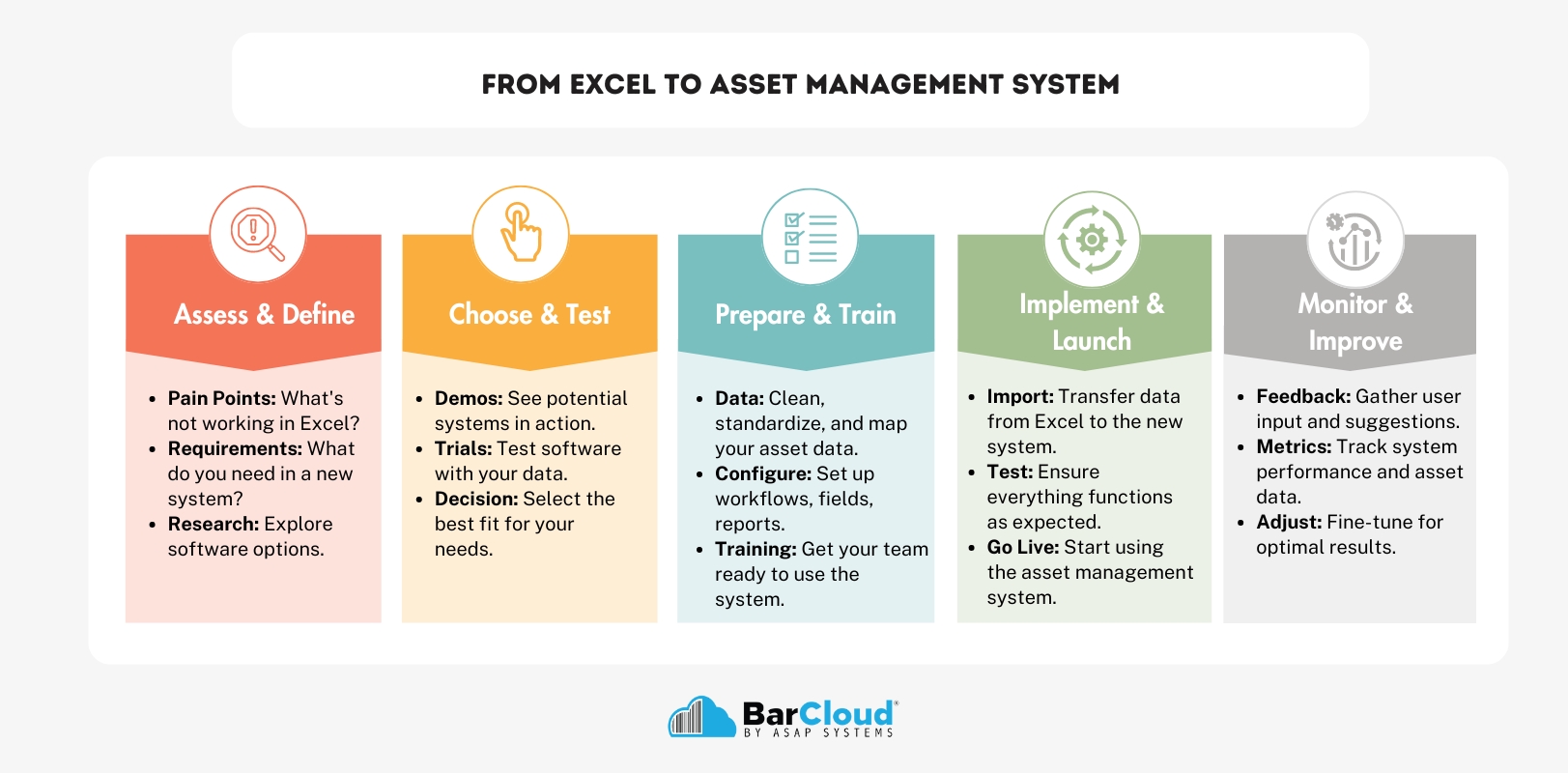
The importance of IT asset management (ITAM)
In today’s fast-paced digital world, IT assets are the backbone of any successful business. But managing these assets effectively can be a daunting task. That’s where IT Asset Management (ITAM) steps in, offering a comprehensive solution to track, optimize, and safeguard your valuable technology investments.
The Importance of ITAM
-
-
- Maximize ROI: Get the most out of your technology investments by identifying underutilized resources, optimizing usage, and avoiding unnecessary purchases.
- Control Costs: Manage software licenses, maintenance contracts, and hardware lifecycles proactively to prevent overspending and reduce unnecessary expenses.
- Mitigate Risks: Safeguard your sensitive data and systems by staying on top of software updates, patching vulnerabilities, and ensuring regulatory compliance.
- Enhance Security: Maintain a comprehensive inventory of your IT assets, their configurations, and access controls to identify and address potential security threats.
- Boost Productivity: Equip your employees with the right tools and resources, streamlining operations and freeing up IT staff to focus on strategic initiatives.
- Make Informed Decisions: Gain valuable insights into your IT infrastructure to make data-driven decisions about future investments and upgrades, aligning technology with your business goals.
-

In essence, ITAM is the key to unlocking the full potential of your IT assets, transforming them from mere tools into strategic drivers of business growth. By implementing a robust ITAM strategy, you can gain a competitive edge, reduce costs, and ensure the long-term success of your organization. .
See the breakthrough using our IT asset management system -> https://asapsystems.com/press-releases/inventory-asset-tracking-it-pr060/
What’s the difference between Current Assets & Fixed Assets?
In the world of business finance, assets are the lifeblood of any operation. They represent the resources a company has at its disposal. But not all assets are created equal. There’s a fundamental distinction between those that are easily converted to cash in the short term (current assets) and those that are held for the long haul (fixed assets). Let’s dive deeper into their differences.
1- Current Assets
-
-
- Time Horizon: Short-term (less than one year).
- Liquidity: High (easily converted to cash).
- Purpose: Day-to-day operations, meeting short-term needs.
- Examples: Cash, accounts receivable, inventory.
- Accounting: Reported at current value.
- Impact on Financials: Reflects short-term financial health.
-
2- Fixed Assets
-
-
- Time Horizon: Long-term (more than one year).
- Liquidity: Low (not easily converted to cash).
- Purpose: Generating revenue, supporting long-term growth.
- Examples: Property, plant, equipment, land.
- Accounting: Reported at net book value (cost – depreciation).
- Impact on Financials: Reflects long-term investment and capital structure.
-
Click here to see our Barcode Software in action -> https://asapsystems.com/press-releases/inventory-asset-tracking-banking-pr009/
What is an equipment tracking system?
Unlock the secrets to efficient asset management with equipment tracking systems – your key to maximizing resources, minimizing losses, and streamlining operations.
Asset Tracking Excels Over Spreadsheets -> https://asapsystems.com/blog/inventory-asset-tracking-blog0064/

Is asset management software suitable for small businesses?
Asset management software isn’t just for big corporations anymore. In fact, it’s a game-changer for small businesses like yours.
Imagine having a crystal-clear view of all your assets – from laptops and tools to vehicles and machinery. No more guessing where something is or when it needs maintenance. That’s the power of asset management software!
Don’t let valuable assets slip through the cracks. Take control with our asset management software and watch your business thrive. Try our free demo today and see the difference it can make!
Click here for the full tour of our standalone asset management system -> https://asapsystems.com/customers/standalone-system/standalone-asset-software/
What are the implementation challenges of asset management software?
Key Challenges in Implementing Asset Management Software
Successfully implementing asset management software requires overcoming several key hurdles:
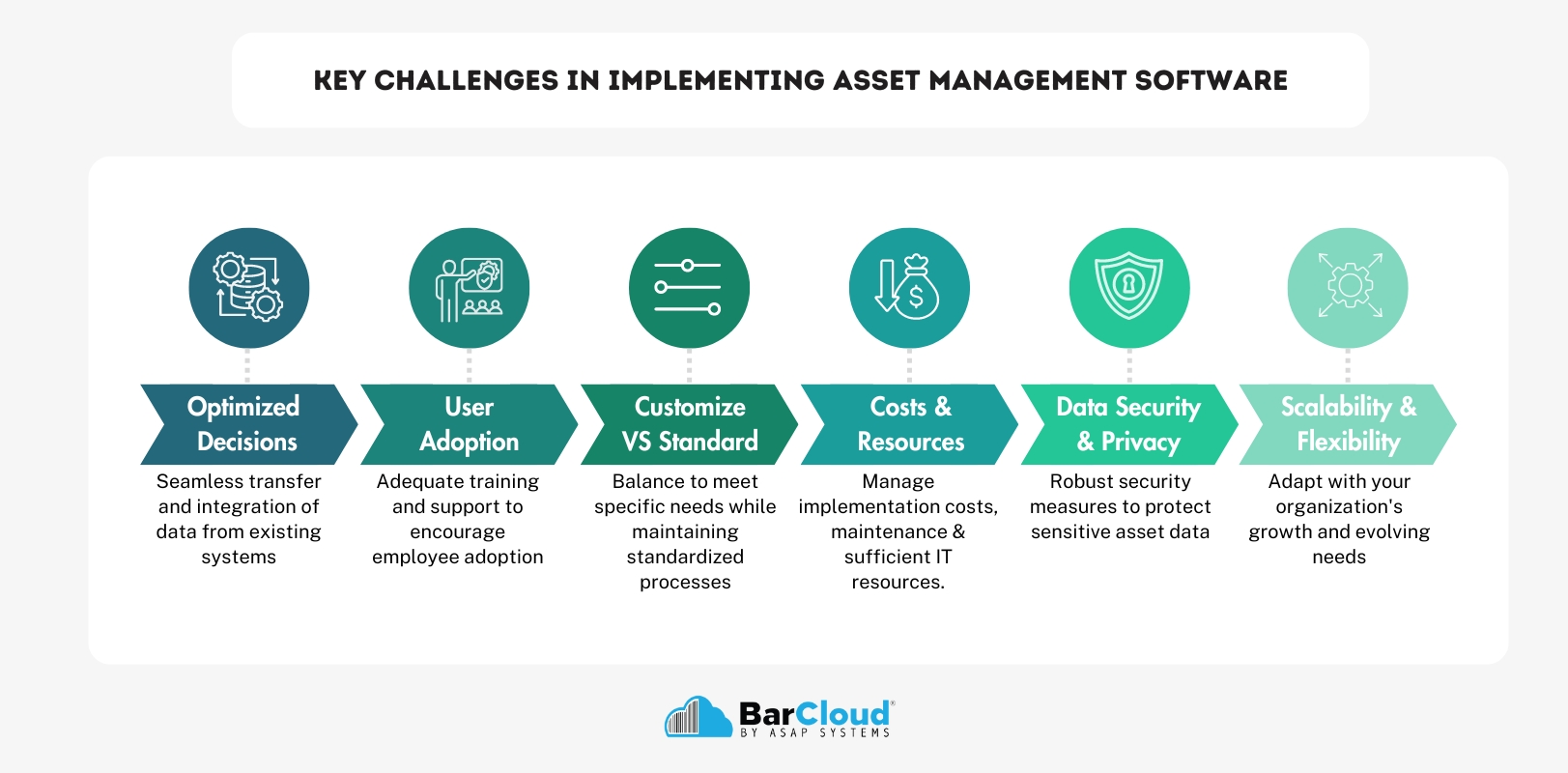
Proactively addressing these challenges will ensure a smooth and successful software implementation, leading to improved asset utilization, cost reduction, and enhanced operational efficiency.
Here’s how to prepare your organization to implement a Barcode Tracking Solution -> https://asapsystems.com/blog/inventory-system-asset-tracking-blog149/
Cloud-Based vs. On-Premise Asset Management Software: A Guide to Choosing the Right Solution
Asset management software is essential for businesses to track and optimize their valuable assets. However, choosing between a cloud-based and on-premise solution can be a daunting task. Let’s break down the key differences and considerations to help you make an informed decision.
1- Cloud-Based Asset Management Software: The Agile and Accessible Choice
Pros:
-
-
- Accessible from anywhere with an internet connection, enabling remote work and flexibility.
- Scalable to meet changing business needs without substantial upfront hardware investments.
- Cost-effective, with subscription models spreading costs over time.
- Automatic updates and maintenance handled by the provider, freeing up your IT resources.
- Robust data security measures implemented by reputable providers.
-
Cons:
-
-
- Limited control and configuration compared to on-premise solution.
- Reliance on internet connectivity, which can be a challenge in areas with limited access.
- Potential concerns over data ownership and security if not choosing a trusted provider like us and our top-tier inventory management solution.
-
2- On-Premise Asset Management Software: The Configurable and Controlled Option
Pros:
-
-
- Greater control over data, configuration, and security procedures.
- Offline access, ideal for environments with limited or no internet connectivity.
- Tailored to fit specific business processes and workflows.
- Full ownership and control over your data.
-
Cons:
-
-
- Higher upfront costs due to hardware and software investments.
- Requires dedicated IT staff for installation, maintenance, and updates.
- Limited scalability compared to cloud solutions.
- Potential for outdated software and security vulnerabilities if not diligently maintained, unlike our always up-to-date cutting-edge inventory solution.
-
Which is Right for Your Business?
The ideal choice depends on your specific needs and priorities. Consider the following:
-
-
- Budget: If you have limited upfront capital, a cloud-based solution like ours might be more appealing.
- IT Resources: If you lack a dedicated IT team, a cloud-based solution eliminates the burden of software maintenance.
- Scalability: If you anticipate significant growth, a cloud-based solution offers greater flexibility to scale.
- Configuration: If your business has unique processes, an on-premise solution might provide greater configuration options.
- Data Security and Ownership: If these are top priorities, carefully evaluate both options. Reputable cloud providers like us offer robust security, but on-premise solutions offer complete control.
- Offline Access: If you need access to data without internet connectivity, an on-premise solution is necessary.
-
Need Expert Guidance?
Choosing the right asset management software is crucial for your business’s success. If you’re still unsure which option is best for you, reach out to our experts. We’ll help you assess your needs and recommend the ideal solution to optimize your asset management.
Need help? Contact us through here -> https://asapsystems.com/company/barcloud-contact-us/
Secure Your Assets & Data: Barcode Asset Tracking with SOC2 Compliance & Advanced Security
Safeguarding your organization’s valuable assets and the sensitive data that tracks them is paramount. Our barcode asset tracking software offers a multi-layered approach to security, combined with SOC2 compliance, to provide the highest level of protection.
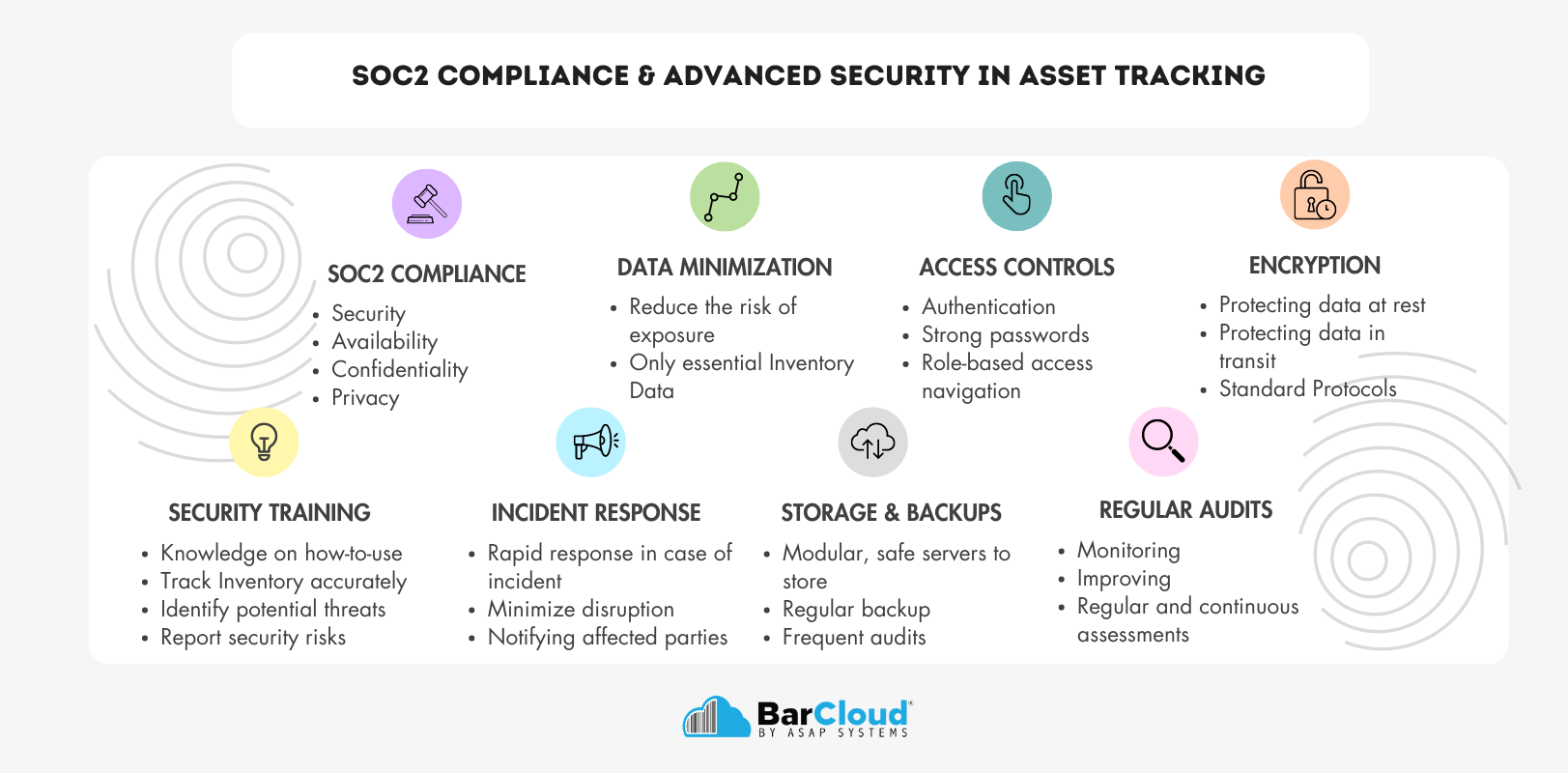
Key Security Features:
-
-
- SOC2 Compliance
- Data Minimization
- Robust Access Controls
- Encryption
- Secure Storage & Backups
- Comprehensive Security Training
- Incident Response & Breach Notification
- Regular Security Assessments
-
With our barcode asset tracking software, you can have confidence that your valuable assets and the data that tracks them are protected by comprehensive security measures.
Learn More About Our Approval Cycles, Advanced Security & Signature Capture aspects and how they can benefit your business >>>
What is the role of barcodes in asset management?
Barcodes have revolutionized asset management by providing a simple yet powerful way to track and manage valuable assets throughout their lifecycle. Here’s how they work and the benefits they bring:
How Barcode Asset Tracking Works
-
-
- Unique Identification: Each asset receives a unique barcode, serving as its digital ID.
- Data Capture: Barcode scanners or mobile devices quickly read barcodes, instantly accessing asset information stored in a central database.
- Asset Tracking: This data includes location, condition, maintenance history, depreciation, and more, enabling real-time tracking and management.
- Streamlined Processes: Barcodes automate tasks like inventory updates, asset audits, and maintenance scheduling, improving efficiency and accuracy.
-
Click here to see how our effective barcode system can help -> https://asapsystems.com/blog/inventory-asset-tracking-blog0049/
The Benefits of Tracking Assets with Barcodes
Barcode asset tracking revolutionizes business operations by replacing manual data entry with quick, accurate scans. This streamlines workflows, eliminates errors, and provides real-time asset visibility.
Benefits:
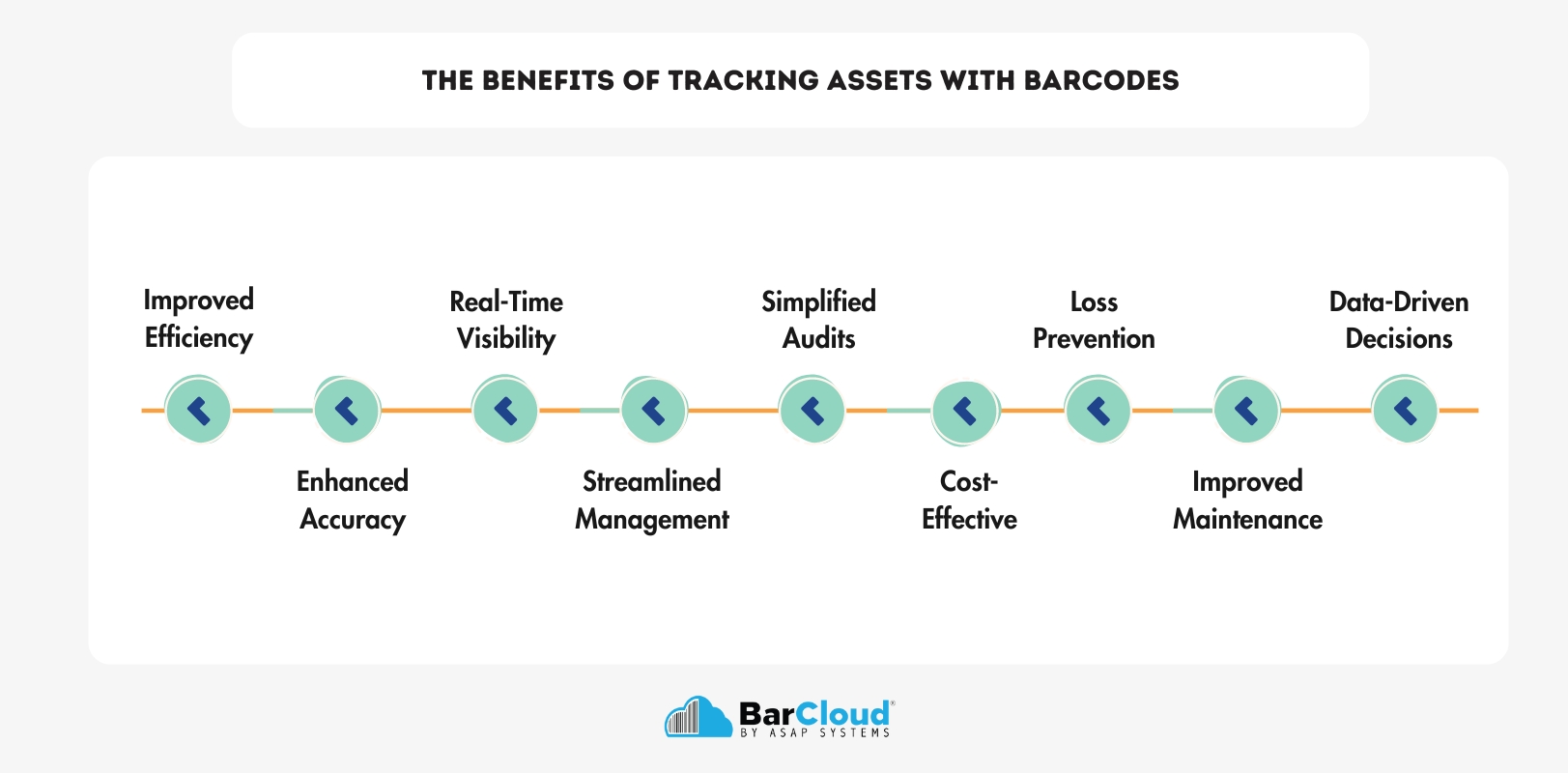
Unlock the power of digital asset management (DAM) today and propel your business to new heights of operational excellence.
Read more about the benefits of an Asset Tracking System here -> https://asapsystems.com/blog/inventory-asset-tracking-blog0029/
What is an Asset Audit?
An asset audit is a comprehensive process that verifies and accounts for all your company’s assets, both tangible (e.g., property, equipment) and intangible (e.g., financial investments). This ensures accurate financial records and responsible asset management.
Why Conduct an Asset Audit?
-
-
- Accuracy: Verify the existence, location, condition, and value of your assets.
- Transparency: Uncover errors or inconsistencies in your asset records.
- Decision-Making: Provide reliable data for strategic decisions about asset utilization, maintenance, and disposal.
- Compliance: Ensure adherence to accounting standards and regulations.
-
Click here to learn why Asset Maintenance Is Crucial -> https://asapsystems.com/blog/inventory-asset-tracking-blog0028/
Why Asset Audits Are Crucial for Your Business Success
Regular asset audits play a pivotal role in your business’s success. Here’s how:

In short, asset audits are a strategic investment in your business’s financial health, operational efficiency, and overall success.
See Why You Should Invest In SaaS -> https://asapsystems.com/blog/inventory-asset-tracking-blog0070/
Depreciation Methods: Understanding the Options for Your Assets
Depreciation is an accounting method used to spread out the cost of a physical asset over its useful life.
There are several ways to calculate this decrease in value (depreciation), and each has its own pros and cons. Let’s break down the main methods you can choose from in our asset tracking system:
1- Straight-Line Depreciation:
This is the simplest method. Each year, the same amount is deducted from the asset’s value until it reaches its salvage value (what it’s worth at the end of its useful life).
-
-
- Pros: Easy to understand and calculate.
- Cons: Doesn’t reflect that assets often lose more value in their earlier years.
-
Annual Depreciation Expense = (Cost of Asset – Salvage Value) / Useful Life
2- Double-Declining Balance Depreciation:
This method speeds up depreciation in the early years. It recognizes that some assets are more productive when they’re newer.
-
-
- Pros: Can be more accurate for assets that lose value quickly.
- Cons: More complex to calculate than straight-line.
-
Depreciation Expense = (Book Value at Beginning of Year) * (Depreciation Rate)
3- Sum-of-the-Years’ Depreciation:
This is another accelerated method, but the calculation is a bit different.
-
-
- Pros: Offers another way to factor in the faster value loss of some assets.
- Cons: Also more complex than straight-line.
-
Depreciation Expense = (Remaining Useful Life / Sum of the Years’ Digits) * (Cost – Salvage Value)
Which Method is Right for You?
The best depreciation method depends on the specific asset and your company’s preferences. In our system, you can easily switch between methods to see which one works best for your needs. Keep in mind that each method will affect your financial statements and taxes differently.
What is Internet of Things (IoT) Asset Tracking?
Internet of Things (IoT) asset tracking is a revolutionary technology that utilizes internet-connected devices, sensors, and software to monitor the real-time location, condition, and movement of physical assets. By leveraging technologies like GPS, RFID, Bluetooth, and cellular networks, businesses can gain valuable insights into their assets’ whereabouts, usage patterns, and maintenance needs.
How It Works
IoT asset tracking devices are attached to physical assets, such as vehicles, equipment, or inventory. These devices collect data on the asset’s location, performance, and condition, and transmit this information to a central platform via the internet. The platform then processes the data and provides businesses with real-time visibility into their assets’ status.
Click here to see the features that help in tracking -> https://asapsystems.com/blog/inventory-asset-tracking-blog0048/
Unlock the Benefits of IoT Asset Tracking
IoT asset tracking is revolutionizing industries by enabling businesses to monitor their valuable assets in real-time. This technology offers a wide array of benefits that streamline operations, enhance security, and drive cost savings. Let’s delve into how IoT asset tracking can transform your business:

Incorporating IoT asset tracking into your business strategy is a wise investment. It’s a powerful tool that enhances visibility, security, efficiency, and ultimately, your bottom line. Embracing this technology positions your business at the forefront of innovation, ready to thrive in the ever-evolving landscape of the Internet of Things.
The factors that make us your best choice for an Asset Tracking System -> https://asapsystems.com/blog/inventory-asset-tracking-blog0052/
What is IT Asset Disposition (ITAD)?
IT Asset Disposition (ITAD) is the comprehensive process that organizations use to securely and responsibly manage the end-of-life of their IT equipment. This includes decommissioning, data sanitization or destruction, equipment remarketing or resale, and environmentally friendly recycling or disposal. ITAD ensures data security, regulatory compliance, and environmental responsibility throughout the entire IT asset lifecycle.
Click here to learn more about our IT management systems -> https://asapsystems.com/blog/inventory-asset-tracking-blog0061/
ITAD Best Practices for Success
1- Thorough Planning and Documentation:
-
-
- Create a detailed inventory of all IT assets.
- Classify data based on sensitivity and regulatory requirements.
- Develop a clear ITAD policy outlining procedures and vendor selection criteria.
-
2- Secure Data Sanitization and Destruction:
-
-
- Utilize certified data erasure software for reusable equipment.
- Employ physical destruction methods for highly sensitive data or media.
- Obtain a Certificate of Destruction from the ITAD vendor as proof of proper data sanitization or destruction.
-
3- Partnering With The Right Vendor:
-
-
- Ensure the vendor provides a detailed chain of custody report.
- Sign a data security agreement outlining the vendor’s responsibilities for data protection.
-
Click Here To See Why We Are The Right Inventory System Vendor -> https://asapsystems.com/blog/inventory-asset-tracking-blog0012/
Closing the Loop: How ITAD Completes the IT Asset Lifecycle
ITAD (IT Asset Disposition) is the final, yet crucial stage of the IT Asset Lifecycle Management (ITAM) process. While ITAM oversees the entire lifespan of IT assets, from acquisition to retirement, ITAD focuses on the responsible and secure disposal of these assets at the end of their useful life.
Integrating ITAD into your ITAM strategy offers several benefits:
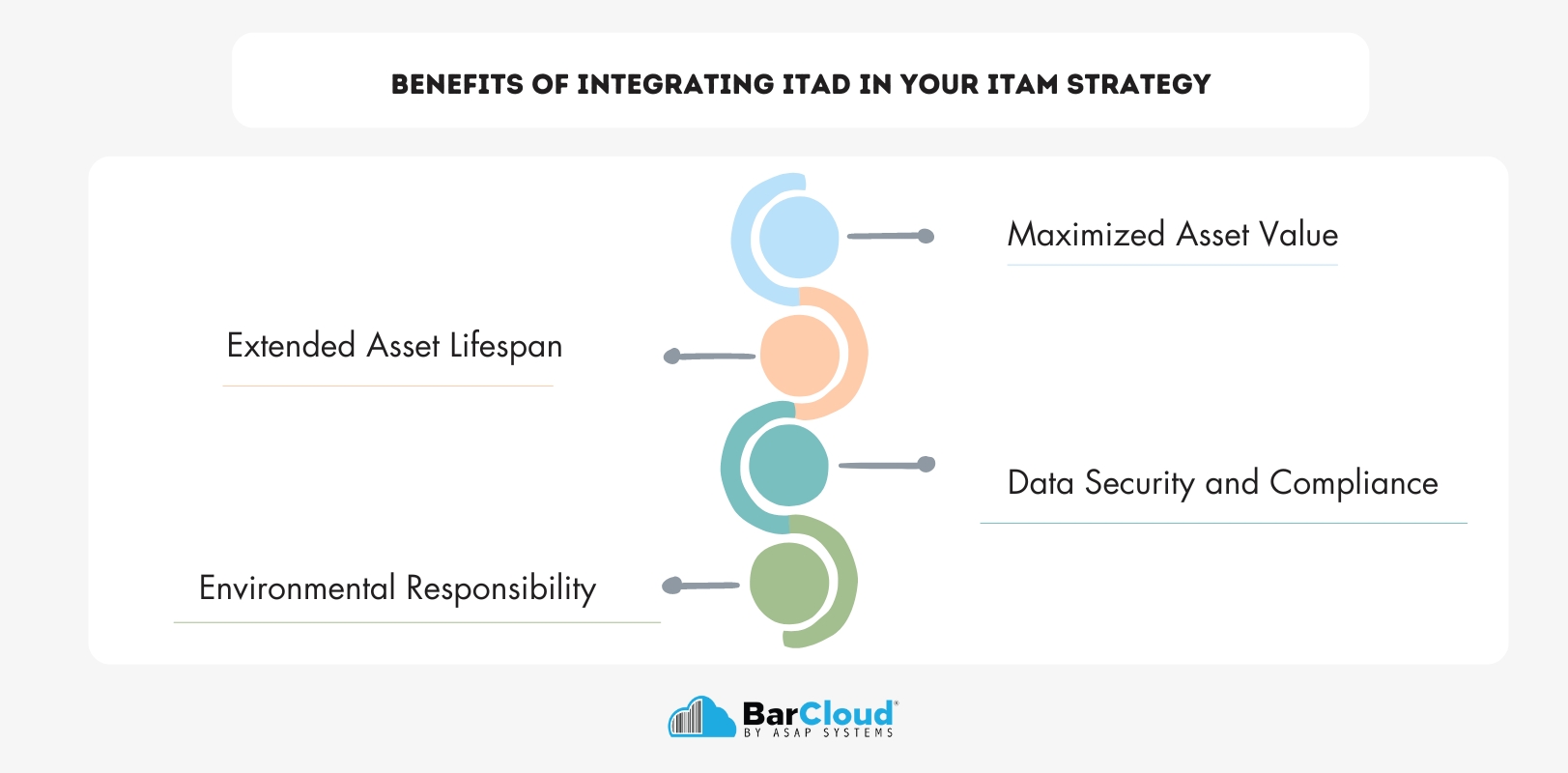
By implementing effective ITAD practices as part of your broader ITAM strategy, you can optimize the value of your IT investments, protect sensitive data, and contribute to a more sustainable future.
Learn More About Managing your Assets’ Lifespans Through Transactions -> https://asapsystems.com/blog/inventory-asset-tracking-blog0050/
Conclusion
Thank you for delving into our comprehensive guide on asset management systems. We hope this exploration has illuminated the vital role these systems play in maximizing the value and performance of your organization’s assets.
As you’ve discovered, effective asset management isn’t just about tracking—it’s about optimizing lifecycles, reducing costs, and driving data-informed decisions. By applying the knowledge gained from this guide, you’re poised to transform your assets from simple resources into powerful engines of growth.But the journey doesn’t end here. The next step is to empower your organization with the right asset management system.
That’s our area of expertise.
Tailored to the unique needs of your business, our Asset Management System provides a robust suite of tools that streamline asset tracking, maintenance, and lifecycle management.
Other Guides

Guide
Inventory management software for government agencies
What is Government Inventory Management?Government inventory comprises a wide array of items necessary for daily operations. Effective management, often facilitated by inventory management software for government agencies, ensures availability when needed, preventing shortages or overages. By utilizing such specialized software,…
Guide
Asset Management Government Guide
What is Government Asset Management?Government asset management, the strategic oversight of public resources to ensure efficient use and maximum benefit for communities, is improving by utilizing tools like asset tracking software for local government. This software, often integrated into…

Guide
Inventory Guide
What is an Inventory Management System?An inventory management system is a tool or set of tools that help businesses track and manage their inventory levels, orders, sales, and deliveries. It serves as the backbone for businesses to monitor stock quantities,…
Guide
Asset Management Education Guide
What is an Asset Tracking System in Education?An asset tracking system in education is a software or hardware solution designed to help schools and universities monitor and manage their physical assets, ranging from student-issued tech like laptops and tablets to…






